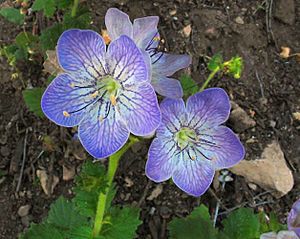Largeflower phacelia facts for kids
Quick facts for kids Largeflower phacelia |
|
|---|---|
 |
|
| Scientific classification | |
| Genus: |
Phacelia
|
| Species: |
grandiflora
|
Phacelia grandiflora, also known as the largeflower phacelia, is a beautiful wild plant. It's a type of phacelia that grows naturally in the sunny coastal hills and southern mountains of California and Baja California. You can often find it in places like coastal sage scrub and chaparral, which are types of dry, shrubby habitats. It even pops up in areas that have recently had wildfires!
Contents
What is Largeflower Phacelia?
Plant Appearance and Size
The largeflower phacelia is an annual herb. This means it grows from a seed, flowers, produces new seeds, and then dies all within one year. Its stem can grow straight up, sometimes branching out, and can reach up to one meter (about 3 feet) tall.
The plant feels a bit sticky because it is glandular. This means it has tiny glands that produce a sticky substance. It's also covered in both soft and stiff hairs, which give it a fuzzy look.
Leaves and Flowers
The leaves of the largeflower phacelia can be up to 15 centimeters (about 6 inches) long. They have edges that look like teeth and can be round or oval shaped. Each leaf grows on a long stalk called a petiole, which connects it to the main stem.
The plant's flowers grow in a special cluster called an inflorescence. This cluster is usually on one side of the stem and curves or coils like a snail shell. The flowers themselves are shaped like wide bells and are also hairy and sticky. Each flower can be up to 2.5 centimeters (about 1 inch) long. They are usually purple or blue, often with a lighter color in the center, like a pale throat.
A Note on Skin Contact
It's important to know that touching the largeflower phacelia can sometimes cause a skin rash in some people. This is because the sticky, glandular hairs on its stems, leaves, and flowers can release tiny oil droplets that might irritate sensitive skin. If you see this plant, it's best to admire it without touching.

